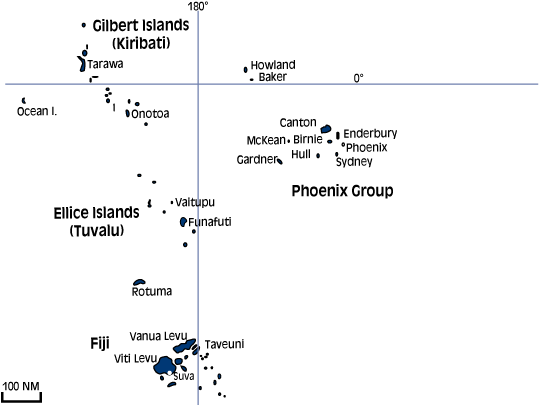 |
|
|
|
|
|
|
|
|
|
|
|
||
|
|
|
||
pp. 16 – 18
Context:
The Phoenix Islands Settlement Scheme

Throughout the first half of the twentieth century, British island possessions in the Central Pacific were administered by the Western Pacific High Commission (WPHC) headquartered in Suva, Fiji. Five hundred miles to the north of Fiji lay the Ellice Islands (Tuvalu) which include Emily’s birthplace, Funafuti Atoll, and Foua Tofiga’s home island of Vaitupu. Several hundred miles north of the Ellice Islands are the Gilbert Islands (Tungaru). Although the British lumped these two neighboring archipelagos together as the Gilbert & Ellice Islands Colony (G&EIC), the two peoples spoke mutually unintelligible languages and regarded themselves as distinctly separate peoples. During the late 1930s and early 1940s, the G&EIC was administered by a Resident Commissioner who lived on Ocean Island to the west of the Gilberts and answered to the High Commissioner of the WPHC in Fiji, the redoubtable Sir Harry Luke.
The Phoenix Islands Settlement Scheme (with perhaps history’s most unfortunate acronym, PISS), was approved in 1938 as a means of relieving overpopulation in the southern Gilberts. It also had the distinction of being the last colonial expansion of the British Empire. The scheme was a project of the G&EIC and was the brain-child of Henry E. “Harry” Maude, then Lands Commissioner for the colony. His assistant, and later the Officer-in-Charge of PISS, was a dedicated young Cadet Officer by the name of Gerald B. Gallagher. Despite the reference to “officers,” the administration of these colonial possessions was not a military or naval function and the individuals who served in the islands were non-uniformed civil servants.
Under the settlement plan, impoverished, landless families were recruited from islands in the southern Gilberts such as Arorae and Onotoa, to settle the uninhabited Phoenix Group which lay some 500 miles to the southeast. Evaluated in October 1937, only three of the eight islands of the archipelago were found to be suitable for cultivation and settlementSydney, Hull and Gardnerand each was given a Gilbertese nameManra, Orona, and Nikumaroro respectively. Because Manra and Orona had previously seen some development as coconut plantations they could immediately absorb several dozen settlers when colonization began in late 1938/early 1939, but Nikumaroro was a clean slate with only 111 coconut trees surviving from a brief planting foray in 1892. Ten men began clearing the dense tropical forest in December 1938 and settlement of the island officially began when they were joined by their families in April 1939, bringing the island population to twenty-three.
The Phoenix Islands Settlement Scheme pushed forward despite the outbreak of war in Europe in September 1939. Funding and resources, never plentiful, became increasing difficult to obtain and what progress was made was due primarily to Gallagher’s inspired leadership and unflagging efforts on behalf of the settlers. The 29 year-old officer quite literally worked himself to death and died on Nikumaroro of an intestinal condition known as “sprue” on September 27, 1941. The loss of Gallagher, followed shortly by the outbreak of war in the Pacific, effectively arrested the further development of the three Phoenix settlements. The island group was well outside the war zone and there is no record of any Japanese activity on or near any of the three settled atolls. In July 1944, Nikumaroro’s southeastern tip became the site of a 25-man U.S. Coast Guard LORAN navigational facility which was subsequently shut down in December 1945 and dismantled in May of 1946. No British administrator had been in residence on the island since Gallagher’s death and it was 1949 before clearing and planting operations on the island resumed in earnest.
An active international commercial airport on Canton Island, built and operated as a military facility during the war, provided employment for many of the residents of the three settled islands. The villages on Manra, Orona and Nikumaroro struggled along for another fourteen years but periodic droughts defeated attempts to make the islands self-sustaining and, in 1963, the British finally abandoned the scheme and evacuated the settlers, leaving the three atolls once more uninhabited.
In the late 1970s the British colonial system peacefully transitioned to self government for the indigenous peoples. The Ellice Islands adopted their ancient name and became the nation of Tuvalu, while the Gilbert Islands became, in 1979, the Republic of Kiribati (pronounced KIRibas, the local pronunciation of the English word “Gilberts”). The islands of the Phoenix Group are now part of Kiribati but remain uninhabited except for a few families on Kanton (formerly Canton Island).

Back to Archive List
